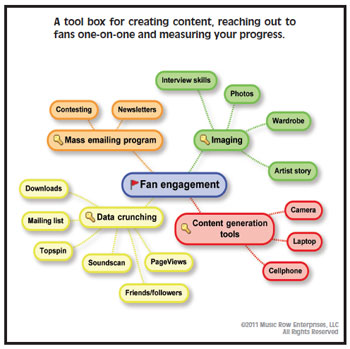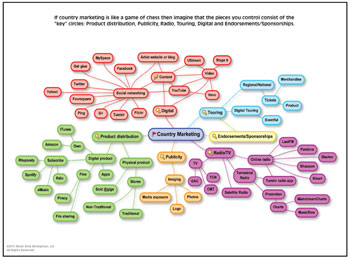
 If country marketing is like a game of chess then imagine that the pieces you control are named Product Distribution, Publicity, Radio, Touring, Digital and Endorsements/Sponsorships.
If country marketing is like a game of chess then imagine that the pieces you control are named Product Distribution, Publicity, Radio, Touring, Digital and Endorsements/Sponsorships.
[Reprinted from MusicRow Oct./Nov 2011]
Taking the chess analogy one step further, there are a number of sophisticated moves that each of these pieces can complete. In fact, sometimes it is advantageous to create combo moves where two different pieces support each other and affect a situation where the whole becomes greater than the sum of the parts. It will require planning, expertise and experience to decide which moves are both affordable and will push a career forward. Too many plans can exhaust your resources and cause you to fall out of the game too soon. Too few, and you’ll never achieve star velocity.
As with all journeys, good directions are essential. In the case of building a country music artist career that need still applies, although the pathway from “unknown” to “household name” is a lot more complex than just getting from point A to B. Hopefully, the mind maps and circles presented in this article will help ease your passage.
But before you begin familiarizing yourself with the various tools and techniques, let’s absorb some basic research about the fans you are hoping to acquire.
According to the massive CMA Country Music Consumer Segmentation study presented in 2009, approximately two in five American adults ages 18-54 (37%) qualify as “Country Music Fans.” These Fans split into two groups based upon revenue contribution—a small core group (4.7%) who invest heavily and a larger group of “Low Funding” fans who engage with country for free (32.6%).
The core fans, or CountryPhiles and MusicPhiles, skew female (54%), are more likely to be married (59%), caucasian and from small towns versus the average American adult. They appreciate the core values of the format and the artists. And, their commitment translates to both significant engagement time and industry revenue.They are an extremely valuable group, perhaps 15 million people, that pay over 50% of the country music bills.
 The low funding portion of fans (100+ million) skew a bit more male (55%). They are younger, more diverse (especially Hispanic) and more urban. They are extremely hip, high tech, engaged music lovers who happen to include Country Music in the mix.
The low funding portion of fans (100+ million) skew a bit more male (55%). They are younger, more diverse (especially Hispanic) and more urban. They are extremely hip, high tech, engaged music lovers who happen to include Country Music in the mix.
This CMA data is now several years old. No doubt, all segments have more effectively embraced the digital revolution and unfortunately, have also been adversely affected by the weak economy.
Now let’s look at the mind maps. Here’s a brief rundown of the six “key” areas on the map…
Product Distribution
The Product Distribution area splits into digital and physical pipelines. The digital side is much less expensive because there is no inventory to create, ship, etc. Consumers are interacting with digital product via paid downloads (Own), monthly all you can play payments (Subscribe) and unpaid channels (Free) which often means P2P piracy. Physical shelf space at major music retailers is now mostly the exclusive domain of major labels and established artists. However, physical product can be profitable, especially for sale at gigs.
Publicity
DIY (do it yourself) is all the rage, but adding a publicity expert to your team can still be a wise investment. When it comes to imaging and getting a realistic appraisal of an artist’s media skills, one can’t rely solely on Mom. A publicist can be essential in taking your story to the media and you to another level.
Touring
Gigs are a musician’s lifeblood. Even superstars will tell you, touring is where the money is. Start regionally. Be sure to acquire fan emails whenever possible, and have merchandise and product on hand. Social networking sites can also help you to interact with acquired fans in a more personal way (without leaving home).
Endorsements/Sponsorships
You don’t have to be playing arenas and stadiums to get one of these coveted partners. But it is crucial to find a brand that fits nicely with who you are and the fans you attract. Get creative in finding a way to make it fit. Think about local, regional and national brands. Find out what the brand expects from you and make sure you deliver.
Radio
Only a few years ago, this area was limited to terrestrial radio for country music. Today add satellite and online to the mix. Plus there are new hybrid arrivals like Pandora and Last.FM competing for listeners’ attention. Competition means additional opportunities.
Digital
Digital marketing and all it entails has become an absolute necessity for success. The list of outlets is substantial with new ones busting loose almost daily. Digital begins with content, video and social networking. Leveraging these areas can provide low cost, high power energy to your career when used in a conscientious daily regimen. Artists should be at least somewhat familiar with every red circle company on the map. The landscape is fragmented with lots of choices. Try to discover the ones that best match with your fans.
Fan Engagement Tools
The Engagement mindmap is a tool box for creating content, reaching out to fans one-on-one and measuring your progress. Taming your mass email program is a must. Analyzing your marketing efforts is how you begin to see what works best and fine tune your strategy. Content generation tools and imaging also play a large role in helping you implement strategy. Good luck and remember the term “overnight success” was invented by Hollywood. Don’t confuse it with “reality.” •

Category: Artist, Exclusive, Featured, Sales/Marketing, Weekend
About the Author
Journalist, entrepreneur, tech-a-phile, MusicRow magazine founder, lives in Nashville, TN. Twitter him @davidmross or read his non-music industry musings at Secrets Of The ListView Author Profile



